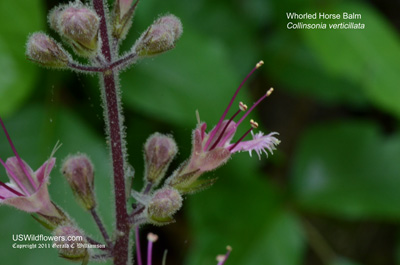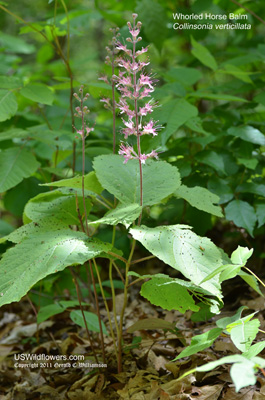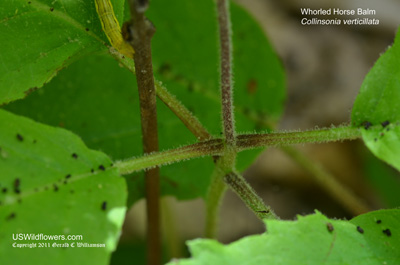Whorled Horsebalm, Early Stoneroot - Collinsonia verticillata
|
Collinsonia verticillata - Whorled Horsebalm, Early Stoneroot. Collinsonia currently has 4 recognized species, although there have been as many as 10 in the past. This implies significant variation within some species.
Found in nine mostly southeastern states (AL, FL, GA, KY, NC, OH, SC, TN, VA), Collinsonia verticillata is listed as endangered in Ohio and Kentucky.
Found in:
AL, FL, GA, KY, NC, OH, SC, TN, VA
Leave comments on Collinsonia verticillata at this link. | 
Distribution of Collinsonia verticillata in the United States and Canada:

Blue=Native; Grey=Introduced
Map from USDA Plants Database:
USDA, NRCS. 2017. The PLANTS Database (http://plants.usda.gov, 08 May 2025). National Plant Data Team, Greensboro, NC 27401-4901 USA.
Search Our Database: Enter any portion of the Scientific, Common Name, or both.
Do a general Google search of the entire site:
#ad
 Follow USWildflowers on Twitter
| | Site: Lookout Mountain, Hamilton County, TN Date: 2011-April-25 | Photographer: Gerald C. Williamson
Nikon D7000
Tamron SP 90MM f/2.8 AF Macro | | The blossoms of Whorled Horse Balm are in groups of 3 to 6 at each node in the inflorescense. | | 
| | Site: Lookout Mountain, Hamilton County, TN Date: 2011-April-25 | Photographer: Gerald C Williamson
Nikon D7000
Tamron SP 90MM f/2.8 AF Macro | | The blossoms of Whorled Horsebalm have 4 stamens on distinctively long filaments. The inflorescence is covered with glandular hairs. The lower lip of the corolla is fringed. | | Click on the photo for a larger image

| | Site: Lookout Mountain, Hamilton County, TN Date: 2011-April-25 | Photographer: Gerald C Williamson
Nikon D7000
Tamron SP 90MM f/2.8 AF Macro | | Whorled Horsebalm is usually 1 to 2 feet tall, with large, opposite, toothed leaves borne on a petiole. | | Click on the photo for a larger image

| | Site: Lookout Mountain, Hamilton County, TN Date: 2011-April-25 | Photographer: Gerald C Williamson
Nikon D7000
Tamron SP 90MM f/2.8 AF Macro | | The top two pairs of opposing leaves are carried so closely together that they may appear to be a whorl rather than opposing, giving the plant the Whorled common name. | | Click on the photo for a larger image

|
|
|
| |
| #ad
|
|






